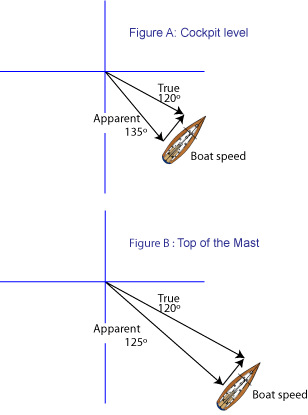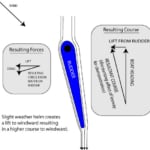Stopping Rounding Up Dead in it’s Tracks
Rounding up is caused by many factors. One is too much wind and force aloft which tends to heel the boat over. This reduces the amount of rudder in the water and thus the rudder’s effectiveness. Another factor in rounding up is the center of pressure of wind on the sails is too far aft which then pushes the aft of the boat downwind and thus the front of the boat up wind.
The NauticEd SailTrim course discusses this topic and so what we wanted to do was test it out for sure. So last weekend we took out a friend’s Beneteau 373 to test out an anti-round up theory. Read on to find out the results of our experiment.
First though, we must first understand wind shear. The phenomenon of wind shear is pretty easy. Wind moves faster at the top of the mast than is does at the water level because the stationary water slows the down the wind in close proximity.
Secondly, consider the concept of true wind vs apparent wind. Which is best understood by imagining driving your car in a cross wind with your hand out the window of the car. At stand still you would feel the wind coming from the side of the car. The faster you go, the more you feel the wind coming from the front of the car. But when a gust of wind comes (which is just an increase in true wind speed) then you would feel the wind shift back more to the side. When relating this to a sailboat, if your boat was standing still, the wind at the top of the mast would be the same apparent direction as at the cockpit level albeit, faster (from the wind shear phenomenon). However as your boat picks up in speed the apparent wind moves forward BUT because of wind shear it shifts forward less at the top of the mast. IE at the top of the mast the wind tends more to the direction of true wind direction because the true wind speed is higher. Thus at the top of the mast the true wind is more aft than apparent wind. Aft means it is coming from a direction further towards the back of the boat. Get it?
So – whether you get it or not. The fact is: at the top of the mast the wind is higher in speed and more aft than at the cockpit level.
Figure A and B show the boat speed, true wind and apparent wind vectors for cockpit level and top of the mast. Obviously in both cases, the boat speed vector must be the same. The true wind vector is obviously the same direction but due to wind shear it is longer (faster) at the top of the mast. This results then in the apparent wind direction being more aft. IE in this case from 135 deg to 125 deg.

Wind shear and apparent wind phenomenom
Thirdly, you should understand that if a sail is sheeted in to tight it creates more heel. This then is exactly what is happening at the top of the mast. Even though at the bottom of the sail you may have perfectly trimmed the sail, the top of the sail is sheeted in too tight against higher wind speed. No wonder you’re getting excessive heeling. And excessive heeling creates round ups.
This is now quite a revelation! It means that the top of the main needs to be “out” further than the bottom of the sail for it to operate efficiently. This is usually indicated by the top telltale. Often the leeward telltale will be stalling at the top of the sail. Especially in high wind because of the phenomena above.

The top of the mainsail needs to go further out so that the starboard telltale can fly smoothly
Thus the top of the mainsail needs to be let out further so that the leeward telltale can fly smoothly. This is commonly referred to as twisting the sail out at the top. Except people believe you are just spilling out (wasting) the wind at the top. Not quite so now, as you’ve just learned. Twisting out the top of the sail is letting the top of the sail fly according to the direction of wind it is feeling.
In the illustration, you can see the top telltale on the downwind side is fluttering. If you let out the main at the top, the wind can reattach to the sail on the leeward side and the telltale will fly smoothly reducing the force aloft.
Understanding all the above. How do we stop rounding up?
Option one: Obviously the first and safe option in higher winds is to reef the sail.
Option two: Let out the traveler which is what most people do when hit by a gust. Just so long as you realize what you’ve done is not twisted the top of the sail out – all you’ve done is let out the mainsail from top to bottom and thus depower the mainsail. This reduces the force aloft and thus the heel. It also moves the center of effort of wind on the sails forward which reduces tendency to round up. The trouble is that you spend all day fighting gusts with still quite a few involuntary round-ups.
Option three: Let out on the mainsheet. Here again you’ve depowered the entire mainsail to handle the gust. Still, it works.
Option four: Permanently reduce the force aloft by letting out further on the mainsail and tightening up on the traveler. The trick here is to bring the mainsail bottom back in again using the traveler. Yes, bring the traveler to windward up past the center point. Most sailors are reluctant to do this because they’ve been taught that it detaches the wind on the leeward side. But not when you’ve let out the mainsheet. In effect, by letting out on the mainsheet, you’ve allowed the boom to rise up and the leech of the sail to slacken. This creates the desired twist at the top and allows the top of the sail to fly according to its apparent direction. At the same time, the bottom of the sail can fly according to its apparent direction.
By trimming the traveler and mainsheet together you can manage the twist at the top of the sail as desired yet still keep power on the bottom of the mainsail. Keeping power on the bottom of the mainsail keeps your speed up which also increases the effectiveness of the rudder. Increasing the effectiveness of the rudder means it can hold more against any turning effect created by the shifting of center of pressure backwards. Wow – see how it is all connected.
What happened on our 15 knot gusty sailing day? Well, not one round up.
So to summarize, the sailing lesson here is when in higher winds bring the traveler up and sheet out the main. You’ll also need to release the boom vang a little. Letting the boom vang out allows the boom to rise which loosens the leech (trailing edge) of the sail and allows the top part to “twist out”.
This and many other finer sail trim concepts are discussed in NauticEd’s Sail Trim Course.
- RYA Day Skipper with NauticEd - April 1, 2024
- NauticEd uses the SailTies GPS Tracking App - March 29, 2024
- Sea of Cortez Flotilla – February 2025 - March 8, 2024






You guys must have been on my boat. This article was very timely. Beer can race with a fairly green crew and blowing 15 w/ gust to 20. We discussed sail twist coming in from the race. This will illustrate it to them better than I can. Thanx.
Great Tip ! I was aware of 1 – 3 Options but not of 4. Well explained.
I do get it! Thanks for the insight. I am now logging on to continue my NauticEd Education!
Cheers,
Greg Luce
If you have an accessible vang on both sides then you can play with the vang before letting the main sheet go when the traveler is on the up hill side.
cheers mark
Grant – this is the clearest explanation I’ve seen on this subject. Even I’ll be able to follow the advice through a haze of rum drinks.
Grant, This is amazing AND incredible. I am foredeck crew on a Catalina 30′, and was asking the Skippper JUST last Sunday to explain the finer points of working the traveler vs. the main sheet, if the boom ends up in the exactly the same place relative to the axis of the boat. He launched right into sail twist and, while I could follow and understand everything he was saying, it wasn’t until just now that I had any real understanding of the forces behind sail twist. Now I don’t just have the answer memorized but I UNDERSTAND it. THANKS!
Andrew,
You’re welcome. Understanding is memorizing! :)
If you pull the boom above centerline with the traveler, you have to let the main sheet out to let the boom back to centerline. This lengthens the main sheet which raises the boom up – which takes tension off the leech (back) of the sail – which allows twist.
Grant